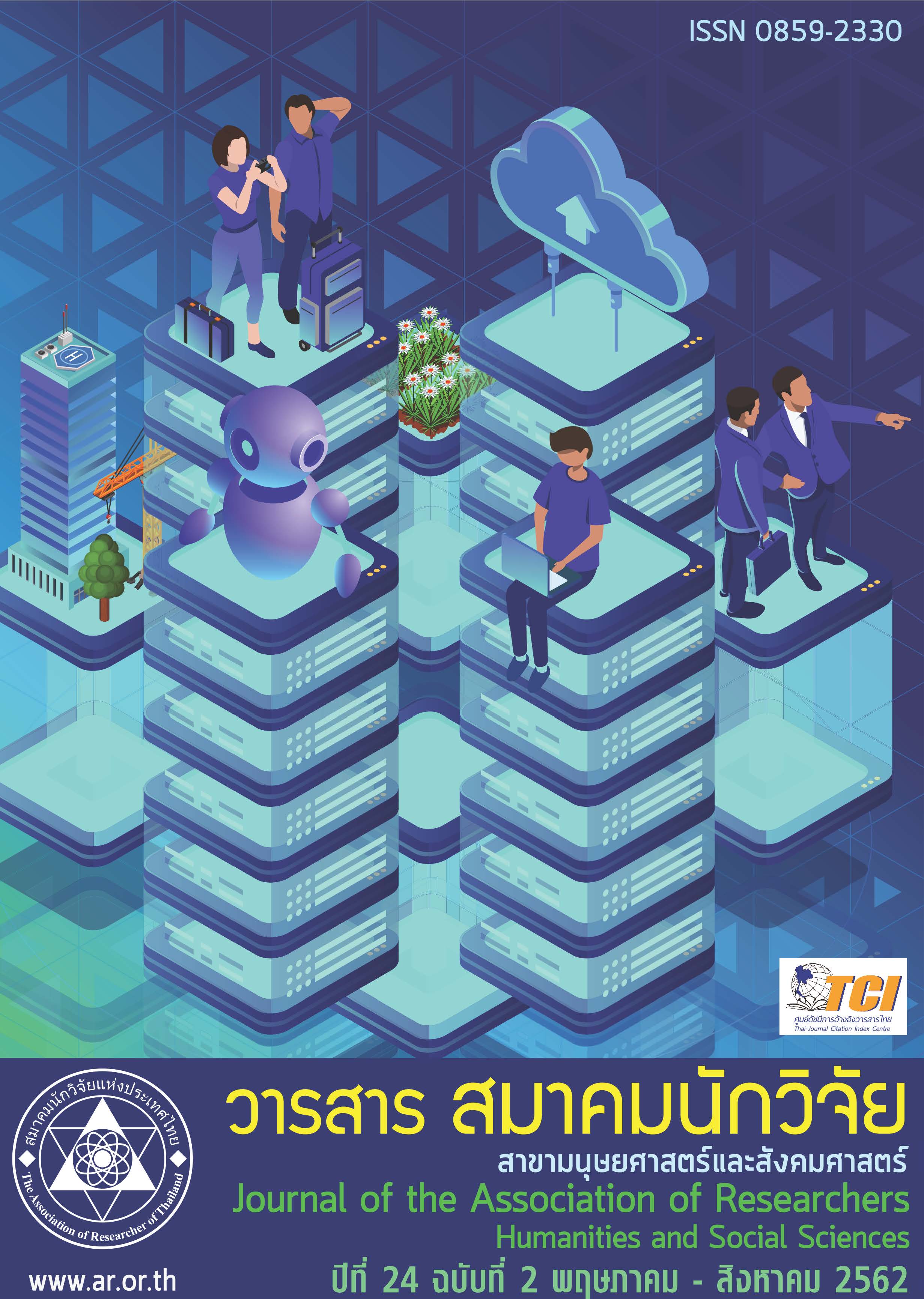The Network Development for Learning Management on History using the 1S2C Process of Schools Under The Prachuapkhirikhan Educational Service Area Office 1
Main Article Content
Abstract
The development of history teacher network can solve the problems of teaching history in the past using reading and reciting method, resulting in students having no chance to be trained on historical process and to be developed on historical analytical thinking skill. The researcher was, therefore, interested in doing this study aiming to develop: 1) history learning management network applying 1S2C process, and 2) history learning outcome applying history learning activities using 1S2C process of schools under Prachuapkhirikhan Primary Education Service Office Area 1. There were 5 steps in this study as follows: 1) studying concepts on development of history learning management network applying 1S2C process, 2) developing the research tools and finding out their quality, 3) developing history learning management network applying 1S2C process, 4) mobilizing the history learning management network applying 1S2C process, and 5) knowledge sharing among schools in the network. The target group consisted of 8 school administrators, 8 teachers, and 249 students. The research tools were: 1) the innovation and 2) the two tools for data collection consisting. The quantitative data were analyzed by using mean and standard deviation, and the qualitative data were analyzed by using content analysis. The research results were as follows: The results of history learning management network development applying 1S2C process of schools under Prachuapkhirikhan Primary Educational Service Area Office 1 were that, in the establishment of history learning management network applying 1S2C process, the network was a situational one, and the mechanism for network mobilization consisted of: 1. Director of Primary Educational Service Area Office , 2. supervisors, 3. school administrators, and 4. history teachers, and that the network teacher development revealed that the teachers could organize 1S2C activities applying 5 steps of historical technique as follows: 1. Preparing questions, 2. Sourcing: S, 3. Corroboration: C, 4. Contextualizing: C, and 5. Concluding and presenting. The results of history learning outcome development by using history learning activities applying 1S2C in schools under Prachuapkhirikhan Primary Educational Service Area Office 1 were that the students had got history analytical thinking skill in overall at a high level. When each aspect was considered, after having attended all history learning activities applying 1S2C, the students had got history analytical thinking skill at a high level (X = 4.19, S.D. = 0.07) and could collect historical evidence by themselves, resulting in a new body of knowledge, pride, and awareness on the value of local historical resources. The research finding revealed that the development of history learning management network applying 1S2C process could help the students have opportunity in developing history analytical thinking skill by using local history learning resources near their schools. Therefore, school administrators should continuously promote the history learning management network applying 1S2C process.
Article Details
บทความที่ปรากฏในวารสารนี้ เป็นความรับผิดชอบของผู้เขียน ซึ่งสมาคมนักวิจัยไม่จำเป็นต้องเห็นด้วยเสมอไป การนำเสนอผลงานวิจัยและบทความในวารสารนี้ไปเผยแพร่สามารถกระทำได้ โดยระบุแหล่งอ้างอิงจาก "วารสารสมาคมนักวิจัย"
References
กระทรวงศึกษาธิการ. (2552). ตัวชี้วัดและสาระการเรียนรู้แกนกลาง กลุ่มสาระ การเรียนรู้สังคมศึกษา ศาสนา และ วัฒนธรรมตามหลักสูตรแกนกลางการศึกษาขั้นพื้นฐานพุทธศักราช 2551. กรุงเทพฯ : โรงพิมพ์ชุมนุมสหกรณ์ การเกษตรแห่งประเทศไทย จำกัด.
ชัยรัตน์ โตศิลา, (2555).การพัฒนากระบวนการเรียนการสอนโดยใช้วิธีการทางประวัติศาสตร์เพื่อส่งเสริมทักษะการคิด ทางประวัติศาสตร์ของนักเรียนมัธยมศึกษาปีที่ 2. วิทยานิพนธ์ครุศาสตรดุษฎีบัณฑิตภาควิชาหลักสูตรและการ สอน คณะครุศาสตร์ จุฬาลงกรณ์มหาวิทยาลัย.หน้า141
ทุติยาภรณ์ ภูมิดอนนิ่ง. (2551). ความรู้ความเข้าใจในวิธีการทางประวัติศาสตร์ และความคิดเห็นเกี่ยวกับการนำวิธีการทาง ประวัติศาสตร์ไปใช้ในการจัดการเรียนการสอนของครูสังคมศึกษาระดับมัธยมศึกษา (ช่วงชั้นที่ 3 ถึง 4) ในจังหวัด ขอนแก่น. วิทยานิพนธ์การศึกษามหาบัณฑิต. ขอนแก่น : มหาวิทยาลัยขอนแก่น. หน้า 18.
ประยูร อัครบวรและคณะ. (2553). การสร้างเครือข่ายและการมีส่วนร่วม (Network Building and Participatory). กรุงเทพฯ : โรงพิมพ์แห่งจุฬาลงกรณ์มหาวิทยาลัย.
พิสิฐ เทพไกรวัล. (2554). การพัฒนารูปแบบเครือข่ายความร่วมมือเพื่อคุณภาพการจัดการศึกษาในโรงเรียนประถมศึกษา ขนาดเล็ก. ดุษฎีนิพนธ์ศึกษาศาสตรดุษฎีบัณฑิต สาขาวิชาการบริหารการศึกษา บัณฑิตวิทยาลัย มหาวิทยาลัย ขอนแก่น.
เรณุมาศ กุละศิริมา และคณะ. (2557). แนวทางในการจัดการความรู้โดยใช้เครือข่ายแหล่งการเรียนรู้ชุมชน ตำบลโคกโค เฒ่า อำเภอเมือง จังหวัดสุพรรณบุรี. โครงการวิจัยเชิงปฏิบัติการแบบมีส่วนร่วม. บัณฑิตวิทยาลัย มหาวิทยาลัย ราชภัฏสวนดุสิต
ศศิพัชร จำปา. (2559). การพัฒนารูปแบบการจัดการเรียนรู้ประวัติศาสตร์ท้องถิ่นโดยใช้แหล่งเรียนรู้ทางประวัติศาสตร์ เพื่อส่งเสริมกระบวนการคิดทางประวัติศาสตร์. ในวารสารฉบับภาษาไทย สาขามนุษยศาสตร์ สังคมศาสตร์ และ ศิลปะ ปีที่ 9 ฉบับที่ 2 เดือนพฤษภาคม – สิงหาคม 2559. มหาวิทยาลัยศิลปากร.
สถาบันสังคมศึกษา. (2560). การเรียนรู้ประวัติศาสตร์ผ่านแหล่งเรียนรู้ทางประวัติศาสตร์. กรุงเทพฯ : โรงพิมพ์องค์การ สงเคราะห์ทหารผ่านศึก.
สำนักงานวัฒนธรรมจังหวัดประจวบคีรีขันธ์. (2559). สุดยอดในสยามที่เมืองประจวบคีรีขันธ์ ศิลปวัฒนธรรมแห่งเมือง. ประจวบคีรีขันธ์ : หจก.อรุณการพิมพ์.
Translated Thai Reference
Akaraborworn Prayoon and Faculty. (2010). Network Building and Participatory. (2010). Bangkok: Chulalongkorn University Printing School.(in Thai)
Songkran Kaew. (2005). Communication network for succession of the ghost dance tradition - Pho Meng. Nonthaburi:Sukhothai Thammathirat Open University. (in Thai)
Social Studies Institute. (2017). Learning history through historical learning resources. Bangkok: Organization Printing Veterans assistance. (in Thai)
Phoomdonning Tuttiyaporn. (2008). Knowledge and understanding of historical methods And comments on the implementation of the wayHistory used in teaching and learning of secondary school social studies teachers (grade 3 to 4) in Khon Kaen province. Master of Education Thesis. Khon Kaen: Khon Kaen University. Page 18. (in Thai)
Sriphahon Siriwan. (2010). History teaching management in educational institutions. Nonthaburi: Publishing Sukhothai Thammathirat Open University. (in Thai)
Champa Sasipatcha. (2016). Development of a model for learning management of local history by using historical sources To promote the historical thinking process. In Thai language journals, Humanities, Social Sciences and Art, Year 9, Issue 2, May-August 2016. Silpakorn University. (in Thai)
Ministry of Education. (2009). Indicators and core learning content, learning strand, social studies, religion and Culture according to the core curriculum of basic education, BE 2551. Bangkok: The Agricultural Cooperative Assembly of Thailand Limited. (in Thai)
Prachuap Khiri Khan Provincial Cultural Office. (2016). The ultimate in Siam at the city of Prachuap Khiri Khan, the arts and culture of the city.Prachuap Khiri Khan: Arun Printing LP. (in Thai)
Thepkraiwan Pisit. (2011). Development of a collaborative network model for quality of educational management in primary schools Small Dissertation. Doctor of Philosophy Studies Faculty of Management Studies College Khonkaen University. (in Thai)
Renumas Kulasirima and Faculty. (2014). Guidelines for knowledge management by using the learning community network at Khok Kho Sub-districtThao, Muang District, Suphan Buri Province. Participatory action research project College Suan Dusit Rajabhat University. (in Thai)
Tosila Chaiyat, (2012). Development of teaching and learning processes using historical methods To promote thinking skills History of Mattayom Suksa 2 students. Doctor of Philosophy Thesis Department of Curriculum and Instruction, Faculty of Education, Chulalongkorn University. Page 141.(in Thai)


